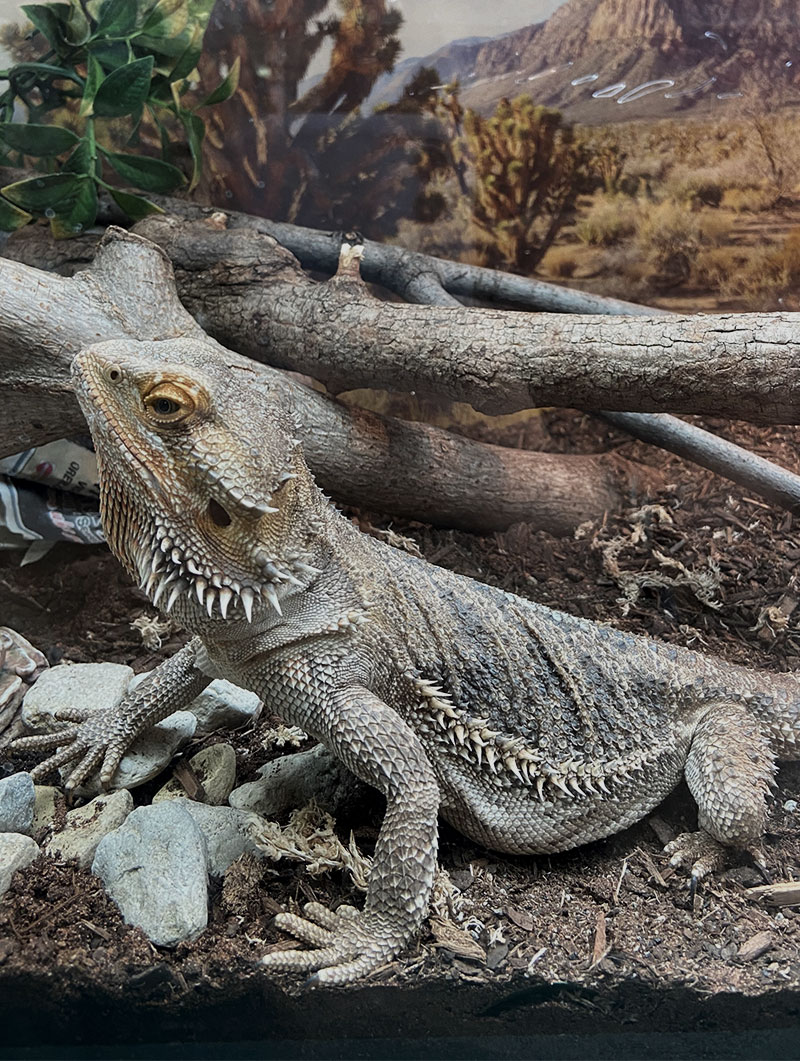Central Bearded Dragon
Pogona vitticeps
Description:
Bearded dragons are medium-sized lizards with broad, triangle-shaped heads, rounded bodies with short legs, and long tails. Body coloration and pattern among individuals is highly variable. Their bodies are covered with spiny scales, which includes a spikey, expandable throat pouch called a “beard” located under their chins. Beards are present in both males and females.
Size:
Adult bearded dragons reach 15.5-23 inches (39.4-58.4 cm) in length and usually weigh 10-18 ounces (283.5-510.3 g). Males are typically larger than females.
Adaptations:
- Bearded dragons are equipped with an armor of spiny scales that can make them difficult for predators to eat.
- The beard is important for communication. When threatened, a bearded dragon will open its mouth, raise its chin, and puff out its beard to make itself appear bigger and more intimidating. In some cases, they may also hiss. They also communicate by changing the color of their beards to black and bobbing their heads.
- Bearded dragons’ coloration varies based on the color of the soil where they live, allowing them to camouflage with their surroundings. This is helpful when hunting and avoiding predators.
Diet:
Bearded dragons live in habitats where food can be difficult to find, so they are opportunistic feeders, consuming whatever they can find. In the wild, their diet consists of leaves, flowers, fruit, and small animals such as insects, other lizards, and rodents. At Cosley Zoo, the bearded dragon eats a variety of dark greens, vegetables, fruits, crickets, mealworms, and pinkie mice. She also receives a multivitamin supplement.
Reproduction:
Males have a very showy courtship ritual used to attract females. The ritual may involve pounding their feet on the ground, waving their arms, and bobbing their heads. Mating occurs during Australia’s spring and summer, between September and March. Females can store sperm for extended periods of time, allowing them to lay two separate clutches of up to 27 eggs from a single mating. Incubation temperature can determine the sex of embryos: eggs containing embryos with male chromosomes will instead develop as females if the environmental temperatures are higher than usual. The eggs hatch after an incubation period of 67-80 days.
Shelter and space needs:
In the wild, bearded dragons are found across most of Australia, in habitats with warm and arid climates such as deserts, subtropical woodlands, savannas, and scrublands. They bask in the sun to warm themselves and can burrow underground to avoid extreme heat or predators. Bearded dragons are semi-arboreal and are often found on fence posts and tree branches.
Life expectancy:
Bearded dragons have a lifespan of 4 to 10 years.
Relationship with man:
In bearded dragons’ native range, introduced predators, such as foxes and domestic cats, are a major threat to populations. In the 1960s, Australia banned the export of wild bearded dragons to better protect the existing populations. Although their export is still banned, there is a large captive bred population, and they are becoming increasingly popular as pets in the United States. Domesticated bearded dragons come in a variety of color morphs not commonly found in the wild.
Fun Facts:
- These lizards are diurnal, which means that they are most active during the day.
- There are eight species of bearded dragons recognized today.
- During cooler seasons, wild bearded dragons may go through brumation, a type of hibernation, in which they stop eating and only drink water sporadically.
- Bearded dragons will sometimes stand on three legs and wave one of their forelimbs in a circular motion. Scientists believe they do this as a form of species recognition and to show submission towards more dominant individuals.






